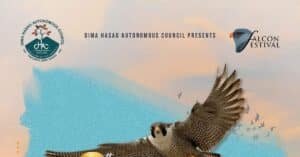The story Amur Falcon in North East India is an inspiring one for wildlife activists. The Amur Falcon, small but spirited birds, embark on an incredible migration journey from the Siberia in the Northern Hemisphere to South Africa in the Southern Hemisphere via Northeast India covering over 22,000 kilometers. They are the longest travelling raptors in the world. In this blog, you will read about their stay in North East India and an inspiring story of conservation.
The Journey and the Stop-over of Amur Falcon
Every year, the Amur Falcons embark on an incredible long journey from the cooler climes of the Northern Hemisphere to the warmth of the Southern part of Africa. In northeast India, these remarkable birds make a brief yet awe-inspiring appearance. North East India is the roosting ground for Amur Falcon. However, their stay is rather fleeting, as they only grace the region from the last week of October till mid-November. Witnessing the Amur Falcons during this time is a testament to the extraordinary phenomenon of migration and a reminder of the beauty of the natural world.
Roosting Site of Amur Amur Falcon in North East India
The Doyang river dam in Pangti village, nestled in the picturesque Wokha district of Nagaland, serves as a crucial stopover for the Amur Falcons during their migration. It is the biggest roosting site of Amur Falcon in North East India. In Manipur, the Tamenglong district plays host to large flocks of raptors, offering them temporary refuge for a few weeks. In Assam, the Dima Hasao district features isolated roosting sites where these falcons can be spotted.
However, their story is not just a tale of migration but also a story of transformation and conservation efforts.
The Story of Amur Falcon in Nagaland
The story goes to picturesque Pangti village in Nagaland. In the local dialect of Nagaland, the Amur Falcon was referred to as ‘Eninum,’ signifying the birds that fly in pairs. These birds were also known as ‘Osenboro,’ which translates to foreign birds. The villagers believed that these avian travelers carried foreign diseases.
For generations, the Amur Falcons had found solace in the tranquil embrace of Pangti village. These small but vibrant raptors had roosted here for ages, and the locals marveled at their graceful flights across the sky. In times past, the villagers believed that these foreign birds might bring with them foreign diseases, and so the falcons remained untouched and unkilled.
Everything changed with the construction of the Doyang River Dam, its shimmering waters encircling Pangti village. The dam brought with it an unexpected consequence—more and more Amur Falcons started visiting. Their numbers swelled, and with them, the curiosity and temptation of the villagers. In 2005, the stillness of the village was broken by the slingshot of catapults as the hunting began. Each villager, on average, hunted about 100 birds per day. As their numbers increased, hunters transitioned to airguns, significantly amplifying the impact on the falcon population. Villagers discovered that a few well-placed nets could ensnare hundreds of Amur Falcons in a single day, further endangering the species. And the killing continued till 2012.
The Nagaland Wildlife and Biodiversity Conservation Trust, along with other ornithologists, were made aware of the Amur Falcon killings in the Doyang area of Nagaland. Their visit to Doyang in 2012 was an eye-opener, as they had no prior knowledge of the scale of the killings until they witnessed it firsthand. The practice had been ongoing since 2005, with the birds being sold in markets in Kohima and neighboring areas for a meager price of Rs. 30-40 per falcon.

- Amur Falcons being carried to local markets for sale. Photo Credit: The Pangti Story
Upon photographing the events and engaging with the hunters, the activists uncovered the full extent of the issue. Pangti, being a remote corner of Nagaland, had remained unnoticed by government authorities, and the local population was unaware of the significance of the Amur Falcon. The report by the wildlife activists garnered national and international attention, leading the state government to issue a notice to the Pangti village council, demanding an immediate halt to the killings.
However, they faced resistance from the hunters, who were earning significant sums, with each individual making around Rs. 50,000 during the Amur Falcon migration season. Subsequently, a Memorandum of Understanding (MoU) was signed between the Wildlife Trust of India, the Nagaland government, and neighboring village councils to put an end to the killings. Finally, the killing of Amur Falcon in North East India stopped and conservation began.
Thanks to these efforts, ten years later, the birds have become an icon in the state of Nagaland. The area of roosting ground of Amur Falcon has been increased and people of Nagaland are taking initiative in its protection. Even as Nagaland celebrates an annual Hornbill festival, smaller-scale Amur falcon festivals have started in Pangti Village. The falcon arrives as a revered guest. Pangti Village is also known as the Amur Falcon Capital of India.














